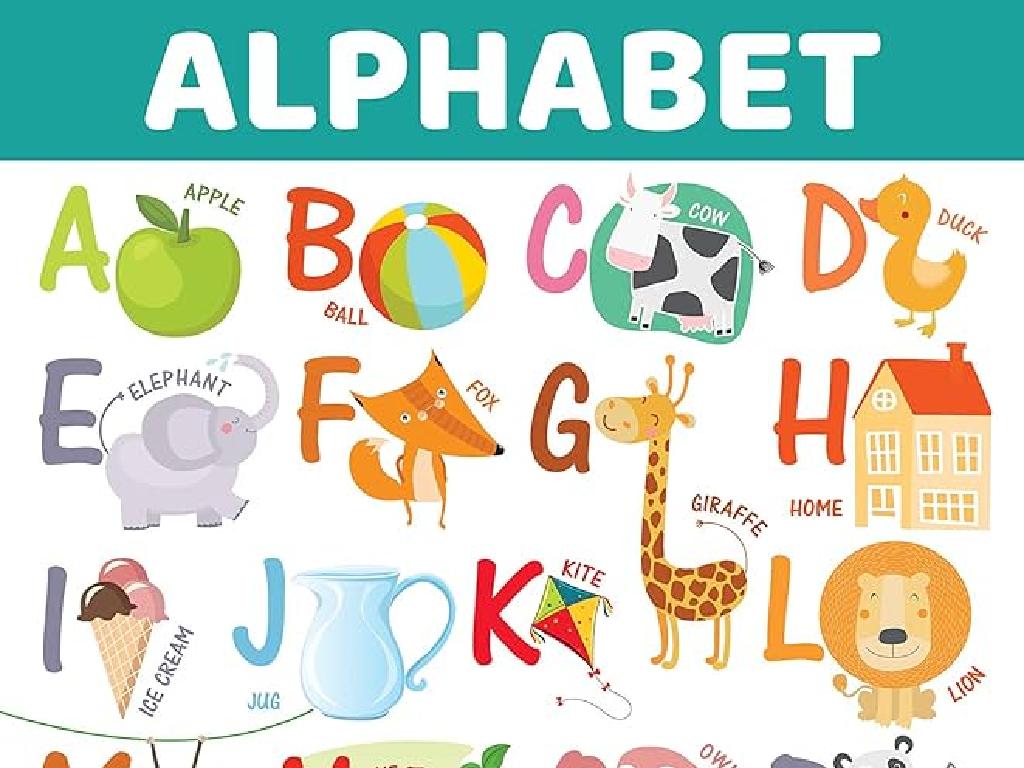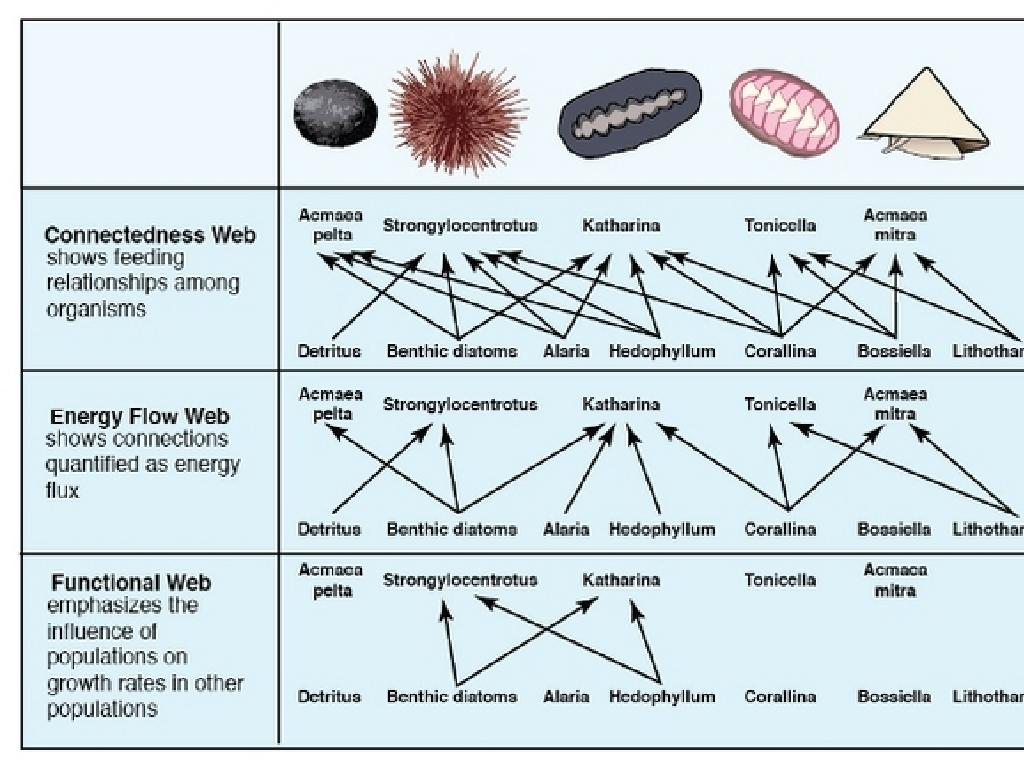Compare Properties Of Objects
Subject: Science
Grade: Fifth grade
Topic: Materials
Please LOG IN to download the presentation. Access is available to registered users only.
View More Content
Exploring the Properties of Objects
– Discovering material properties
– Materials have qualities like hardness, flexibility, and color
– Everyday materials and their uses
– Wood is hard and used for furniture, metal is strong for building
– Significance of material properties
– Properties determine how we use materials in daily life
– Classifying materials by property
– Sort materials as conductors or insulators, metals or plastics
|
This slide introduces the concept of materials science and emphasizes the importance of understanding the properties of materials in the world around us. Students should learn that materials have specific properties that make them suitable for certain uses, such as wood for furniture or metal for construction. Discuss the significance of these properties in everyday life and how they influence the way materials are chosen for different applications. Engage students in a class activity where they classify common materials based on their properties, such as thermal conductivity or malleability. This will help them to connect the theoretical knowledge with practical examples and enhance their understanding of the subject.
Exploring Materials Around Us
– What are materials?
– Substances used to make things
– Common materials we use
– Paper, plastic, metal, wood, glass
– Materials form our world
– Everything is made from materials
|
This slide introduces the concept of materials in the context of science for fifth graders. Begin by defining materials as the substances from which objects are made. Provide relatable examples that students encounter in their daily lives, such as paper, plastic, metal, wood, and glass. Emphasize that everything in the physical world is composed of materials, whether naturally occurring or man-made. Encourage students to look around the classroom and identify objects and the materials they are made from. This will help them understand the diversity of materials and their properties, setting the stage for deeper discussions on how different materials can be compared based on their characteristics.
Exploring Properties of Materials
– Understanding material properties
– Properties are characteristics like color, hardness, and texture.
– Observable & measurable properties
– We can see and measure weight, volume, and temperature.
– Properties’ impact on usage
– The suitability of a material for a task depends on its properties.
– Activity: Material investigation
|
This slide introduces students to the concept of properties of materials. Begin by explaining that properties are the characteristics that help us identify and choose the right material for a job. Discuss observable properties like color, shape, and texture, as well as measurable ones like mass, volume, and temperature. Highlight how these properties determine the use of a material, for example, metal for a frying pan due to its heat conductivity, or rubber for a tire because of its grip and flexibility. Conclude with an activity where students investigate various materials in the classroom, noting their properties and discussing what uses they might be suitable for. This hands-on experience will help solidify their understanding of the relationship between a material’s properties and its potential applications.
Comparing Hardness of Materials
– Understanding Hardness
– Hardness measures resistance to scratching or denting.
– Conducting a Scratch Test
– Use tools to scratch objects and record which ones get scratched.
– Comparing Diamond and Soap
– Diamond, the hardest mineral, won’t scratch easily unlike soap.
– Observations and Conclusions
|
This slide introduces the concept of hardness and how it can be compared among different materials. Hardness is a property that determines how resistant an object is to being scratched or dented. The scratch test is a simple experiment where students use a tool to try and scratch various objects to see which materials are harder. For example, a diamond, being the hardest natural material, will not scratch easily, whereas soap, which is much softer, will scratch readily. Encourage students to think critically about why certain materials are harder than others and how this property can be useful in everyday life. After the experiment, discuss the results and what they reveal about the materials tested.
Flexibility and Rigidity in Materials
– Understanding flexibility vs. rigidity
– Flexibility allows bending without breaking, rigidity resists it
– Class demo: bending materials
– Observe and record how different materials bend or resist
– Discussing flexibility in design
– Flexible design can be important for function and safety
– Why do materials bend differently?
|
This slide introduces the concepts of flexibility and rigidity, which are important properties of materials. Start by explaining that flexibility refers to a material’s ability to bend without breaking, while rigidity means a material resists bending. During the class demonstration, provide various materials such as a rubber band, a plastic ruler, and a metal rod for students to bend and observe. Discuss why flexibility is crucial in the design of everyday objects, such as in earthquake-resistant buildings or flexible phone cases. Encourage students to think about why different materials bend differently and how this property is essential in various applications. The activity will help students understand the practical implications of material properties in engineering and design.
Exploring Density and Buoyancy
– Understanding Density
– Density is mass per volume. Think of a sponge vs. a rock.
– Buoyancy Basics
– Buoyancy determines if objects float. It’s about an object’s density vs. water.
– Activity: Buoyancy Prediction
– Activity: Buoyancy Testing
|
This slide introduces the concepts of density and buoyancy, which are fundamental in understanding why objects either float or sink. Density is defined as the amount of mass in a given volume, which can be demonstrated with a comparison between a sponge (less dense) and a rock (more dense). Buoyancy is the force that allows objects to float, which is influenced by an object’s density relative to the density of water. The class activity will involve students predicting whether certain objects will float or sink and then testing their hypotheses. This hands-on experience will help solidify their understanding of these concepts. Provide a variety of objects for the activity to allow students to observe different outcomes. Encourage them to consider the material properties and shape of the objects as they make their predictions.
Conductivity in Materials: Metals vs. Non-Metals
– What is conductivity?
– Conductivity means how well a material allows heat or electricity to flow through it.
– Comparing metals and non-metals
– Metals often conduct heat and electricity well, unlike non-metals.
– Conductivity in everyday life
– Cooking pots are metal for heat, rubber handles for safety.
– Why conductivity matters
– Understanding conductivity helps us choose materials for different uses.
|
This slide introduces students to the concept of conductivity, focusing on thermal and electrical aspects. It explains that conductivity is a property that determines how well a material can transfer heat or electricity. Students will compare metals, which are typically good conductors, to non-metals, which usually are not. Real-life applications, such as why pots are made of metal and handles are made of rubber, illustrate the importance of understanding conductivity. This knowledge is crucial for making informed decisions about material use in various applications, from cooking to electrical wiring. Encourage students to think of more examples where conductivity is important and to consider safety implications in their everyday lives.
Review and Compare: Material Properties
– Recap properties of materials
– Hardness, flexibility, durability, etc.
– Group activity on object comparison
– Compare objects’ properties in groups
– Discuss material selection influence
– Why choose one material over another?
– Share findings with the class
|
Begin with a brief review of material properties such as hardness, flexibility, and durability. Move on to a group activity where students compare different objects based on these properties. Provide a variety of objects for the students to examine and discuss. After the activity, lead a discussion on how the properties of materials influence their selection for specific purposes. For example, why rubber is used for tires and metal for machinery. Encourage students to think critically about the suitability of materials for different uses. Conclude with students sharing their findings and thoughts with the class. This will help solidify their understanding of the relationship between material properties and their practical applications.
Class Activity: Material Scavenger Hunt
– Find objects with specific properties
– Look for items that are transparent, flexible, or magnetic
– Classify objects by their properties
– Group items by hardness, texture, or buoyancy
– Share your findings with the class
– Discuss how different materials are used based on their properties
|
This interactive class activity is designed to help students understand the properties of materials by engaging them in a scavenger hunt. Provide a list of properties such as transparency, flexibility, and magnetism, and ask students to find objects around the classroom or school that match these descriptions. Once they have collected items, students should classify them based on their properties like hardness, texture, and buoyancy. This will help them to see the relationship between an object’s material and its properties. After the hunt, students will share their findings with the class, discussing why certain materials are chosen for specific purposes. For the teacher: Prepare a diverse set of objects beforehand to ensure that all students can participate. Consider safety and ensure that all items can be handled by the students. Have a discussion guide ready to facilitate the sharing session.
Conclusion: Properties of Materials
– Recap of today’s learning
– Importance of comparing properties
– Understanding material properties helps in choosing the right material for a task.
– Real-life application of knowledge
– This knowledge helps us select materials for everyday objects like clothing, cooking utensils, etc.
– Reflect on what we’ve learned
|
Today, we’ve explored how different materials have different properties such as hardness, flexibility, and conductivity. Understanding these properties is crucial because it helps us make informed decisions when selecting materials for various uses. For instance, we wouldn’t use a material that melts easily for cooking utensils or a brittle material for a playground slide. Encourage students to think about the materials around them and how their properties make them suitable for their purposes. This reflection will help solidify their understanding and appreciation of the material properties in their everyday lives.






